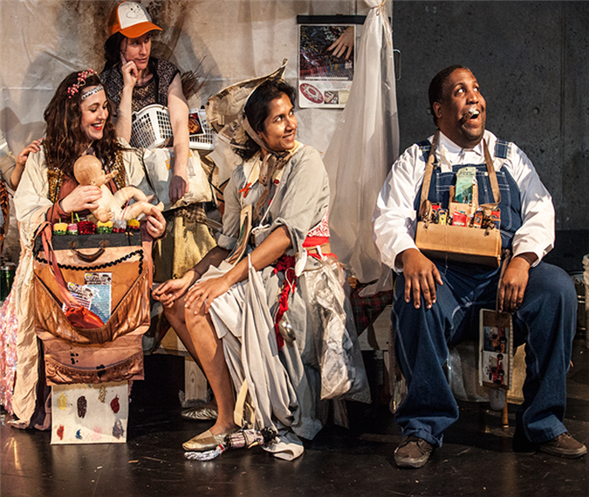Translate Page

It's not every day that a playwright starts her own theatre company and then wins a prestigious, game-changing grant. But such was the case for Sibyl Kempson, whose 7 Daughters of Eve Thtr. & Perf. Co. was founded before she was selected as a USA Rockefeller Fellow last year. "The company came before the grant," says Kempson. "But it seemed cosmically connected."
That concept of cosmic connection is also present in Kempson's shows. Take 7 Daughters' inaugural production, Let Us Now Praise Susan Sontag at the Abrons Arts Center, which Kempson also directs. Inspired in part by writer James Agee and photographer Walker Evans's 1941 book, Let Us Now Praise Famous Men about Southern families during the Dust Bowl era, LUNPSS features sharecroppers who believe that gods and spirits are part of the land. Kempson's reinvention of their world is hardscrabble and destitute, but also imaginative and resourceful.
The first half of LUNPSS focuses on a family of farmers who meet a journalist and a photographer intent on capturing their lives. During the second section, the photographer and journalist are haunted by social critic Susan Sontag, who questions their methods. A delightfully daffy river (or is it Heaven?) flows behind them, and the dead souls of the documented speak to the audience. LUNPSS unfolds through scenes and songs, and draws not just on Agee, Evans and Sontag, but also French Symbolist painter Odilon Redon, Broadway musicals and ancient mythological seals. Kempson tills a fertile soil that is composed of heady philosophy, history, politics, and wordplay.
"Sontag's argument is basically that any documentation of human suffering cannot spur us to take action against it if the documentation is too beautifully rendered," explains Kempson. "I love Sontag and that idea. I was interested in writing about what she was grappling with."
As Kempson researched the story behind Let Us Now Praise Famous Men, she learned that the families Agee and Evans documented were essentially exploited, and were never even sent a copy of the book.
{Image1}
"Redon was painting around the time that photography was coming out, and he was like, 'Photography is death. It can only destroy,'" says Kempson. "We know the photos of these sharecroppers so well, we don't even feel anything [when we look at them]. Sontag writes about that too --- the horror in the photo cannot be separated from the fact that the photo exists." In deference to that realization, Kempson doesn't use any of Evans's iconic images in the show, though she hopes audiences will look them up.
"I ended up writing in this overtly political territory, which is not where I normally go," admits Kempson, who likens the separation of art and journalism to the separation of church and state. She also notes that art can point out a problem, but doesn't necessarily offer any solutions. "It would be arrogant of me to say that my job as an artist is to raise awareness about human suffering," she says. "I know that women are treated badly. I know that there's inequality and poverty --- I feel like what we're lacking is an alternative. My intention was to explore some kind of alternative universe, and imagine something that is more closely aligned with where we want to go."
---
Eliza Bent is a Brooklyn-based writer and performer
Photos by Maria Baranova
Tickets to Let Us Now Praise Susan Sontag are available through TDF's Off-Off@$9 Program.